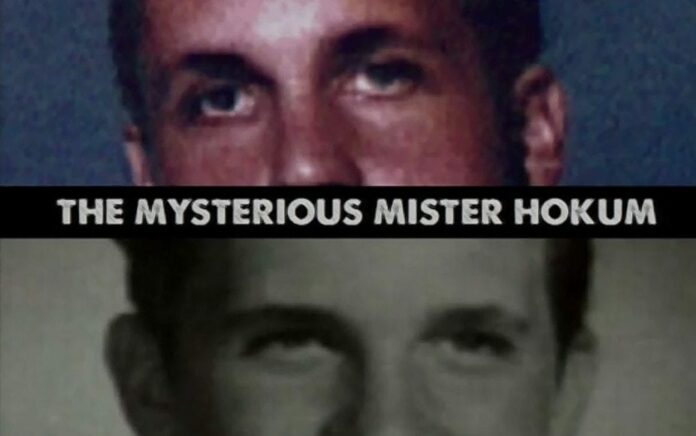
Well-known technology historian Jason Scott tells the extraordinary story of the con artist named John Paul Aleshe, aka Robert Hoquim, at DerbyCon conference.
Welcome to The Mysterious Mister Hokum, presented to you by Jason Scott, proprietor of textfiles.com, documentary filmmaker, famous cat owner, problematic kickstarter, rehabilitation officer, and friend to all in terms of history.

When Robert Hoquim died, he died in the basement apartment that he had in Indiana. He, at that time, was a recently retired owner of an ISP called IQuest in Indianapolis, and he was a beloved member of the community. He was a car collector, he was somebody who would really play the part in the growth of the Internet in the Indianapolis area.
Of course, the police, finding him dead of a heart attack, wanted to find out more about what family members he had and maybe to notify them. And they ran into some problems. First of all, it turned out that his social security identification card wasn’t real. It turned out that it was handmade. And his other information didn’t match up; it matched to other people around the country.
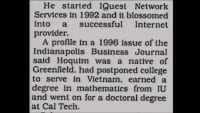 And so, what ended up happening was that this beloved guy had all these holes, and they couldn’t figure out what was going on. Again, he’d been around for years, he was a Vietnam vet, he’d got a degree in mathematics and everything else. It turned out that, in fact, none of that was true. They were able to go to his storage unit to maybe get a little bit more of information, and that is when it really fell apart.
And so, what ended up happening was that this beloved guy had all these holes, and they couldn’t figure out what was going on. Again, he’d been around for years, he was a Vietnam vet, he’d got a degree in mathematics and everything else. It turned out that, in fact, none of that was true. They were able to go to his storage unit to maybe get a little bit more of information, and that is when it really fell apart.
 So, hokum – the concept of hokum is one of not telling the truth, telling a little bit more of a story that, perhaps, you should, and kind of trying to put one over on people. Hokum was, in fact, his last name; Robert Hoquim. And Robert was not named Robert Hoquim.
So, hokum – the concept of hokum is one of not telling the truth, telling a little bit more of a story that, perhaps, you should, and kind of trying to put one over on people. Hokum was, in fact, his last name; Robert Hoquim. And Robert was not named Robert Hoquim.
His actual real name was Robert Aleshe, or I should say John Paul Aleshe. He had, in fact, been on the run for over 20 years.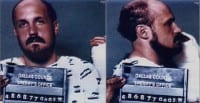 This photo you’re seeing of him (see right-hand image) is a mugshot taken of him in Dallas. The reason he is in a cast is because his finger has been shot off. And the reason his finger has been shot off was because the lack of a partition in the cop car when you’re busting somebody for writing bad checks meant that it was easier just to handcuff the guy and put him in the front of the cop car with you, which meant that when he was able to get one hand out of the handcuffs and he struggled with the cop for the gun. The gun went off and took his finger out. But they needed a mugshot from him, so they took a picture of him with the missing finger anyway.
This photo you’re seeing of him (see right-hand image) is a mugshot taken of him in Dallas. The reason he is in a cast is because his finger has been shot off. And the reason his finger has been shot off was because the lack of a partition in the cop car when you’re busting somebody for writing bad checks meant that it was easier just to handcuff the guy and put him in the front of the cop car with you, which meant that when he was able to get one hand out of the handcuffs and he struggled with the cop for the gun. The gun went off and took his finger out. But they needed a mugshot from him, so they took a picture of him with the missing finger anyway.
John Aleshe had been kind of always on the periphery of getting away with things. He was a person who had run a number of scams, and I’ll mention some of them, throughout his life. I wanted to talk about how I found out about him, and kind of the earlier lessons that I think come from him, and the wider ideas that we get from a guy like this.
Because this is a computer security conference, and security conferences are ones where people discuss the whole manifest of trust in the web. And one of the side effects of this is that people can get really hung up on believing that because they are aware of how things can go wrong, they themselves are fully capable of knowing when things can go wrong; I just wanted to show exactly kind of where it goes and our roots in it as computer industry.
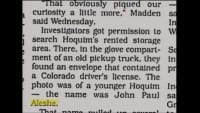 In the glove compartment of a pickup truck that was gassed and ready to go, in the storage unit – only one is mentioned here (see left-hand image) – there were actually multiple fake IDs. Bear in mind: Robert Aleshe was in fact a multi-millionaire at this point, and yet, even at that moment he was keeping a truck ready to go at the slightest provocation in the storage unit, along with whole new identities waiting for him to go.
In the glove compartment of a pickup truck that was gassed and ready to go, in the storage unit – only one is mentioned here (see left-hand image) – there were actually multiple fake IDs. Bear in mind: Robert Aleshe was in fact a multi-millionaire at this point, and yet, even at that moment he was keeping a truck ready to go at the slightest provocation in the storage unit, along with whole new identities waiting for him to go.
 This is a different picture of him (see right-hand image). It looks like he’s younger, but I believe that that’s a hairpiece. He’d been arrested in Colorado, and his scams ranged from simple check cashing, kite schemes – to something called the bust-out. Does anyone know what a bust-out is? Here is how the bust-out works. You go to a place and you ingratiate yourself with the community, and you end up telling people that you’ll help them.
This is a different picture of him (see right-hand image). It looks like he’s younger, but I believe that that’s a hairpiece. He’d been arrested in Colorado, and his scams ranged from simple check cashing, kite schemes – to something called the bust-out. Does anyone know what a bust-out is? Here is how the bust-out works. You go to a place and you ingratiate yourself with the community, and you end up telling people that you’ll help them.
It’s, ironically, a lot of work to do this. You basically have to become friends with people; when there are shitty jobs, nobody wants them, you take them. You offer to get in on stuff and help people with things, and then over time the community depends on you. And that is when you fuck them. You, basically, step in and you say to them: “I came up with a deal. I’ll do this investment with you. You’ll give me some cash, I’ll do some cash; maybe even do one successfully.” But then you push for an unusually large one. And then when the money comes in and you go to do the next part, you disappear. And this is what he had done.
Now you’re probably thinking when I heard about this. The interesting thing is I’m currently 43; I heard about this scam, about him, in 1988, when I was 18. And what had happened was: he was a member of a community on FidoNet. I won’t go too much into FidoNet here, it’s a personal favorite of mine. But think of FidoNet as a computer with a fat guy calling another fat guy. The way that FidoNet worked was that FidoNet’s magic was in its network. And what would happen was you would post a message on FidoNet on the single-use BBS, single-person BBS, and at night, it would call another BBS and it would transfer files at night, very quickly, 3 in the morning. When these were wrong numbers, it was a bad day for that person. They would transfer the files, transfer the messages, and now you would have your post appear on two places. If it sounds weird that you would have to wait a day for an email – that’s the way it worked.
I won’t go too much into FidoNet here, it’s a personal favorite of mine. But think of FidoNet as a computer with a fat guy calling another fat guy. The way that FidoNet worked was that FidoNet’s magic was in its network. And what would happen was you would post a message on FidoNet on the single-use BBS, single-person BBS, and at night, it would call another BBS and it would transfer files at night, very quickly, 3 in the morning. When these were wrong numbers, it was a bad day for that person. They would transfer the files, transfer the messages, and now you would have your post appear on two places. If it sounds weird that you would have to wait a day for an email – that’s the way it worked.
Now, this didn’t scale very well after a couple hundred nodes. So, what they came up with was a much more complicated system; this hub region system. What would happen is that one machine would be designated as the hub, and so the other machines locally – because at the time, back before 20% of you were born, there was local calling vs. long distance, and long distance was expensive, so the idea was that everyone in your local calling area would call one machine, and that machine would then, at night, do the transfer, and that was the hub. And then, over the next day, it would transfer back out.
And this was all had ad hoc, this was all being done by amateurs; it was a fantastically powerful system to be able to transfer things. But it had that one interesting flaw, which was that to be a hub was a relatively expensive process. So, when he joined the community that he was in, John Aleshe, at that time being called John Richard, became the hub.
So, he became the ‘solve-all-your-problems’ amazing guy. He ended up taking everyone’s messages, and then quietly entering into these deals with people about getting some cool grey-market goods and investing in a business and doing everything else. And then one day he went to Boston for a computer convention and never returned. The way they found out was the phone number was disconnected on the BBS; they drove by his house – it was empty. And everybody started to piece together how many of them had invested something in him recently, and that he had blown town, never to return.
Now, some people would just go through various stages, but these folks decided that what they would do was they would sit down and they would write out everything about him they knew. And then they discovered his earlier life as John Aleshe. And then they would put it all in a FidoNet transferred file and send it to all the other FidoNet nodes. This was how I heard about it at 18, about this terrible scam artist who had taken all this stuff from people. They were angry, life savings were gone. But he had disappeared with it, and they were using FidoNet.
Ironically, of course, he moved over two states – we now know. And he opened up another BBS and went back on FidoNet, where, extensively, he got to watch this cry for his head. Now, again, you would think that he would go in for that big scam again. And it was there that he founded what eventually became IQuest, one of the largest Internet service providers of Indianapolis. It turned out that starting an ISP in 1992 to 1995 was like starting a video store in 1980 or 1983 or a video arcade in 1978. Turned out he struck gold. And so, enough money came in that he was not running any fraud; he was just a legitimate businessman who was on the FBI Wanted list.
 So, my question is: how much does it make him different than a lot of other similar organizations in time, a lot of similar other places. Because, if we go ahead and look at the computer industry, and you look at how marketing is done, and you look at how people make promises, it doesn’t always catch up. And unfortunately, we’ve become relatively inured to that situation, haven’t we? We’ve certainly gotten to the point now where we say to ourselves: “Of course, we’re smart and we see this big cell phone.” I mean, certainly, the wave of anger and trauma that comes with any new iPhone release seems to indicate that we are better educated people.
So, my question is: how much does it make him different than a lot of other similar organizations in time, a lot of similar other places. Because, if we go ahead and look at the computer industry, and you look at how marketing is done, and you look at how people make promises, it doesn’t always catch up. And unfortunately, we’ve become relatively inured to that situation, haven’t we? We’ve certainly gotten to the point now where we say to ourselves: “Of course, we’re smart and we see this big cell phone.” I mean, certainly, the wave of anger and trauma that comes with any new iPhone release seems to indicate that we are better educated people.
 This (see left-hand image) is the Altair 8800, which is built as the first home computer, mini-computer, computer just for people that did not fill a room or make missiles fly. There’s an earlier one called the Mark-8. However, the Mark 8 was particularly expensive and was a huge financial burden, so you probably wouldn’t be owning that. It was the Altair that ended up on the cover of Popular Electronics in January 1975.
This (see left-hand image) is the Altair 8800, which is built as the first home computer, mini-computer, computer just for people that did not fill a room or make missiles fly. There’s an earlier one called the Mark-8. However, the Mark 8 was particularly expensive and was a huge financial burden, so you probably wouldn’t be owning that. It was the Altair that ended up on the cover of Popular Electronics in January 1975.
I’ve interviewed many people from that era. And there were people that basically said to me: “This was the moment at which I realized I wanted to own a home computer and I wanted to be a computer owner.” It is a fundamentally beautiful piece of art.
Now, it has no video screen, and for people who might not go back to that time – you were basically flipping those switches on the front to be able to send programs into it. But it was amazing that you could get this thing for $400 in a kit and $498 assembled.
At a time when an Intel chip that would go in here was $400 – now, that should have been a red flag, you would think, right? The $400 chip in this machine plus machine equals $400. But no, what ended up happening was that, in fact, when they put this thing up for sale, it didn’t exist. This computer was myth, it was a gamble, it was an idea, it was a hope.
They had developed a prototype that they thought was pretty good. They had shipped it to Popular Electronics for the cover photo. That was lost in shipping, so they sent them an empty box. So this iconic photo is of an empty box.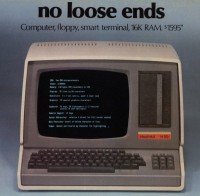 It is a beautiful testimony to the computer industry that has come afterwards. They needed to sell 200 of these things to be able to make them – they had to pre-sell 200. They ended up pre-selling 2000, and within the first year they had manufactured 5000. They were onto something; they had struck oil. But they had not necessarily known that when they put the thing up for sale. So to me it always stands as a beautiful testimony to the industry.
It is a beautiful testimony to the computer industry that has come afterwards. They needed to sell 200 of these things to be able to make them – they had to pre-sell 200. They ended up pre-selling 2000, and within the first year they had manufactured 5000. They were onto something; they had struck oil. But they had not necessarily known that when they put the thing up for sale. So to me it always stands as a beautiful testimony to the industry.
At the time that we’re talking about, there were a lot of ads making a lot of promises. This is a Heathkit terminal (see right-hand image), 16K RAM, only $1595*. It’s got 100 Kbytes storage and two Z80-s.
It occurs to me that I didn’t quite explain Altair 8800. So, wait a minute: “$400+blank=$400, what are you doing?” Here is the trick: they had cut a deal with Intel. Intel had cosmetically damaged terrible-looking chips that were testing functional.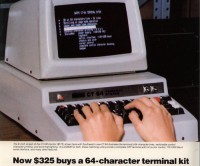 And they made a pre-deal with Intel to sell this chip for $75 if they removed the Intel logo from it. There is your secret sauce, there you go. I expect to see your Kickstarter next week.
And they made a pre-deal with Intel to sell this chip for $75 if they removed the Intel logo from it. There is your secret sauce, there you go. I expect to see your Kickstarter next week.
This industry offered lots of things that were extremely underpowered that were portrayed as wonderful. This (see right-hand image) is a 64-character terminal kit for $325. There’s no CPU – it’s just going to take what you type and put it on the screen. That’s your machine.
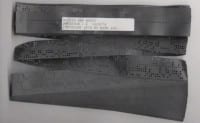 When people promise you more, they’re promising you amazing things for expensive amounts. This is Altair Basic (see left-hand image) that went for the Altair. In 1976 it was written by the two little hippies, Bill Gates and Paul Allen. And I’ve actually found someone who has a receipt from 1978. The price was $213 with tax. This is what $200 gets you. Ah, the software industry, you will never fail me.
When people promise you more, they’re promising you amazing things for expensive amounts. This is Altair Basic (see left-hand image) that went for the Altair. In 1976 it was written by the two little hippies, Bill Gates and Paul Allen. And I’ve actually found someone who has a receipt from 1978. The price was $213 with tax. This is what $200 gets you. Ah, the software industry, you will never fail me.
They ended up seeing so much money in Basic that they split off and had to settle a lawsuit with Altair when they moved away, because it was so amazing. And they left the center of computing at the time, which was Albuquerque in New Mexico, and went to Seattle, where they were never heard from again. So you have a lawsuit over a piece of software from a company that originally lied about having a computer.
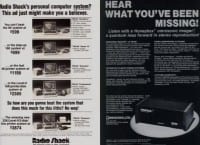 Computers were expensive back then (see right-hand image). The upper left: you cannot beat the 4K system at $599. If you want to have a 16K system, that’s 300 more dollars. And you want to add up a printer – that adds up to $1198. Or the Level II, 16K, printer + disk system bundle at $2385. How are you going to beat it? You’re not. Actually, at the bottom you can see the amazing new 32K, Level II, 2-line printer system for $3874. That was a party. You were like: “Do we buy a second car or do we get a computer?”
Computers were expensive back then (see right-hand image). The upper left: you cannot beat the 4K system at $599. If you want to have a 16K system, that’s 300 more dollars. And you want to add up a printer – that adds up to $1198. Or the Level II, 16K, printer + disk system bundle at $2385. How are you going to beat it? You’re not. Actually, at the bottom you can see the amazing new 32K, Level II, 2-line printer system for $3874. That was a party. You were like: “Do we buy a second car or do we get a computer?”
 Like I said, it was an expensive time, and there were a lot of promises. This (see right-hand image) is Radio Shack, who has turned out to be a relatively legitimate company. On the right is Omnisonix, Ltd, who is offering you a “Honeybox omnisonic imager, a quantum leap forward in stereo reproduction.” There is so much goodness in the copy here, copy that you would take to your own products and apps. And I promise you instant, instant interest. Retro fits to most stereo systems. Now, remember that this was at the time when the RCA plug was the primary interface to an audio box.
Like I said, it was an expensive time, and there were a lot of promises. This (see right-hand image) is Radio Shack, who has turned out to be a relatively legitimate company. On the right is Omnisonix, Ltd, who is offering you a “Honeybox omnisonic imager, a quantum leap forward in stereo reproduction.” There is so much goodness in the copy here, copy that you would take to your own products and apps. And I promise you instant, instant interest. Retro fits to most stereo systems. Now, remember that this was at the time when the RCA plug was the primary interface to an audio box.
“You can now experience the psychological and physiological sensation of what amounts to three-dimensional sound reproduction, what we call Omnisonic Imagery from just two speakers. Sound appears to come out of many sources in the listening area, depending on the quality of the signal source.” It is promising you that this box will change everything. Now, I’ve had somebody who worked here tell me that it was actually pretty awesome, but it was mostly an echo chamber.
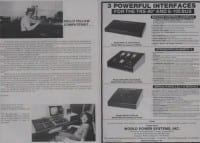 So, in this minefield of what’s real and what isn’t you have something like this (see right-hand image). This is “Hello fellow computerist…” from Perry and Coreen Pollock, who were talking about World Power Systems. World Power Systems, as you can see on the right, offered you wonderful things: three powerful interfaces for the TRS-80 and S-100 bus, consoles, programmers, modules that you could buy; serial parallel I/O modules.
So, in this minefield of what’s real and what isn’t you have something like this (see right-hand image). This is “Hello fellow computerist…” from Perry and Coreen Pollock, who were talking about World Power Systems. World Power Systems, as you can see on the right, offered you wonderful things: three powerful interfaces for the TRS-80 and S-100 bus, consoles, programmers, modules that you could buy; serial parallel I/O modules.
As if through glass, let me tell you about the predator, because everything you’re looking at here is an absolute lie. There is no World Power Systems, there is no such thing being sold. If you give them your money, you’re never going to see that money again.
It gets even better: the two people in the picture are partners of the person and they are about to be screwed. They are painted as the CEO and the Head Treasurer, but, in fact, they have no power whatsoever. World Power Systems existed for one purpose: to advertise in as many magazines as quickly as possible things that did not exist, get you to send them money and then disappear, i.e. the bust-out.
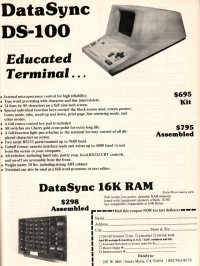 The guy who ran it, the Colonel, had run previously a company called DataSync, the DS-100 Educated Terminal. Colonel Winthrop, which is not his real name, had basically sold this item, this kit (see left-hand image), which also didn’t exist, and had gone to jail. But it was a minimum security prison, so he busted out and started World Power Systems.
The guy who ran it, the Colonel, had run previously a company called DataSync, the DS-100 Educated Terminal. Colonel Winthrop, which is not his real name, had basically sold this item, this kit (see left-hand image), which also didn’t exist, and had gone to jail. But it was a minimum security prison, so he busted out and started World Power Systems.
So dude goes on the run, leaving these two people to get arrested. They were later released. I found an article about it where she showed up. She had since gotten married again, got a kid and was like: “Wow, people still remember this story,” because for her this was well over 30 years ago, but it was still amazing, that World Power Systems.
Now, here’s the thing: in a weird linkup, Tom Jennings, who created FidoNet, needed a group to do some of his electronics projects, and he named it World Power Systems, entirely on purpose, as a reference to these scam artists. And for a short period of time he lived in the same town as the original World Power Systems was running.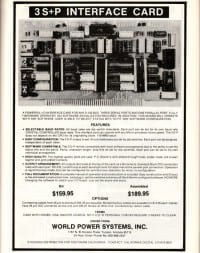 And there were people 25 years later who thought he was the same guy. And he had to address people who were very angry. A quarter of a century later they were angry and bitter at how they got screwed over.
And there were people 25 years later who thought he was the same guy. And he had to address people who were very angry. A quarter of a century later they were angry and bitter at how they got screwed over.
The Colonel, Mr. Hunt – it was his real name, by the way – made one major mistake, and it was the 3S+P Interface Card (see right-hand image). I’ll give you 5 seconds to go: what is the terrible mistake that this con artist made which you should not make? Showing the actual chips wins the game, good job. Don’t show people something that doesn’t work, utilizing chips that don’t do what you put them next to, with no obvious power running to them. This terrible snake oil chip, which could not plug into anything, and which was running all manner of things, immediately got the attention of people going: “I don’t understand what this is,” writing to the paper and things falling apart extremely quickly, causing him to go on the run and the other people to be arrested.
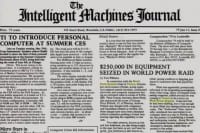 They had brought in, like, $250,000. This (see left-hand image) is an article from 1979 about it; I’ve put it there. It took the World Power Systems group. It turned out that they had gotten a lot of people to give them money. His name was Norman Henry Hunt; he was convicted of fraud. He escaped from Chino, which, apparently, was very easy if it’s minimum security. He was later arrested for this and went to jail.
They had brought in, like, $250,000. This (see left-hand image) is an article from 1979 about it; I’ve put it there. It took the World Power Systems group. It turned out that they had gotten a lot of people to give them money. His name was Norman Henry Hunt; he was convicted of fraud. He escaped from Chino, which, apparently, was very easy if it’s minimum security. He was later arrested for this and went to jail.
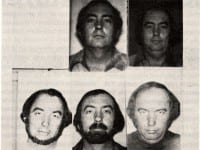 Here’s the Colonel in various mugshots (see right-hand image). It turns out there’s a lot of mugshots of the Colonel for some reason. Colonel’s still in jail. And why is the Colonel still in jail? Well, this is where I just lost my shit because…
Here’s the Colonel in various mugshots (see right-hand image). It turns out there’s a lot of mugshots of the Colonel for some reason. Colonel’s still in jail. And why is the Colonel still in jail? Well, this is where I just lost my shit because…
So, the Colonel was in jail, and it turned out in the 1990s there had been this scandal. It turned out that there was a tax fraud scheme where people were filing tax refunds for people who didn’t exist, and getting thousands and thousands of dollars in tax refunds.
And when they figured out who was doing it, it was a bunch of prisoners, of which he was one of them. They then had to try and convict him for tax fraud in prison, where he was. So, in 1993, in prison, for things he’d done in the 1970s he was committing more fraud to give himself more money. Where does that come from? Where do we find that? That, to me, is the fascinating thing in all of this. Where do these people come from?
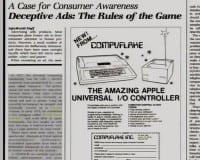 Of course, the other magazines were more than happy and quick to point out: “Oh, we wish that it never happened.” And they produced this article in InfoWorld about how to tell if you’re being scammed (see left-hand image). So they create a fake ad to warn you, which is kind of a things-you-should-be-aware-of deal in a police handbook. You know: “Oh my god, look out, it’s wireless; who could trust something that’s wireless?
Of course, the other magazines were more than happy and quick to point out: “Oh, we wish that it never happened.” And they produced this article in InfoWorld about how to tell if you’re being scammed (see left-hand image). So they create a fake ad to warn you, which is kind of a things-you-should-be-aware-of deal in a police handbook. You know: “Oh my god, look out, it’s wireless; who could trust something that’s wireless? Look at this interactive square black box; who wants to trust a square black box promising you things?” And this is every goddamn ad in every goddamn computer magazine, from then till now, and until the end of time.
Look at this interactive square black box; who wants to trust a square black box promising you things?” And this is every goddamn ad in every goddamn computer magazine, from then till now, and until the end of time.
This (see right-hand image) was the article about him with the tax fraud. And they had actually gotten him $40,000, with total going to $136,000. So it was going pretty well.
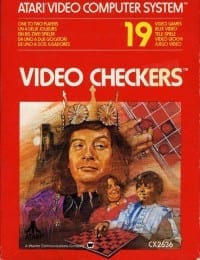 How much scamming is out there? Well, this (see right-hand image), for instance, is the cover of the Atari Video Checkers program for the Atari 2600. This is a beautiful piece of art. This is a proud king overlooking this young man whose lady by his side lovingly adores him as he moves a piece forward with a sense of kingdom and justness.
How much scamming is out there? Well, this (see right-hand image), for instance, is the cover of the Atari Video Checkers program for the Atari 2600. This is a beautiful piece of art. This is a proud king overlooking this young man whose lady by his side lovingly adores him as he moves a piece forward with a sense of kingdom and justness.
This (see image below) is Atari Video Checkers in real life. That’s what that was. That was on the cover; that was inside. And I think that’s something you need to think about. How often have we had that happen, where that was on the outside and this was on the inside. I’m not the only person who thought this, by the way. People have made lots of little tiny jokes about this piece of work. Do we agree to just disagree and to assume that the unreality we’re presented is the way things are?
That was on the cover; that was inside. And I think that’s something you need to think about. How often have we had that happen, where that was on the outside and this was on the inside. I’m not the only person who thought this, by the way. People have made lots of little tiny jokes about this piece of work. Do we agree to just disagree and to assume that the unreality we’re presented is the way things are?
 We have this propensity for kind of overlooking rules (see right-hand image). If we get to things that we want to do, we do them. There’s a concept of a term called the ‘desire path’. In parks, that’s the area of the park that is not paved, but it’s been worn down because people said: “Fuck it, I’m going this way, it’s easier for me.” Life’s riddled with these little desire paths, and to me fraud is the ultimate desire path, which is “Oh, these morals…”
We have this propensity for kind of overlooking rules (see right-hand image). If we get to things that we want to do, we do them. There’s a concept of a term called the ‘desire path’. In parks, that’s the area of the park that is not paved, but it’s been worn down because people said: “Fuck it, I’m going this way, it’s easier for me.” Life’s riddled with these little desire paths, and to me fraud is the ultimate desire path, which is “Oh, these morals…”
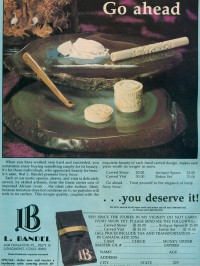 This is a 1970s ad for cocaine accessories from a magazine (see left-hand image). This happened. You know what the best part is? They’re made of ivory. This happened and you would actually be able to order it in a men’s magazine; your cocaine accessories made out of ivory to have sent to your home, because: “You deserve it.” Life changes, right? Things get weird. You look back and you’re like: “I can’t believe anyone would ever fall for that.”
This is a 1970s ad for cocaine accessories from a magazine (see left-hand image). This happened. You know what the best part is? They’re made of ivory. This happened and you would actually be able to order it in a men’s magazine; your cocaine accessories made out of ivory to have sent to your home, because: “You deserve it.” Life changes, right? Things get weird. You look back and you’re like: “I can’t believe anyone would ever fall for that.”
I’m gonna end up writing that waiting in line to the iPhone store or while they’re playing Candy Crush, which is, essentially, a slot machine with candy. I have a real moral issue with Candy Crush. I think it will made illegal in the next 5 years, things like that, because it turns every single aspect of the gaming into a tollbooth, and it preys immediately on your sense of need. It’s basically the gambler’s fallacy combined with Bejeweled. So it’s a very good harbinger of it, and it’s right now. I know they are making millions of dollars a day at it. They are really making millions of dollars on Candy Crush. We’re fine with this, in some ways.
I was lucky enough recently; I put up a page about Mr. Aleshe. I was fascinated by this story. He died in 2000. He was 41 years old. He had, again, just sold his company. He had shocked everyone that he had done this. And when I put all that story of him together I actually went back and I found the people on the FidoNet community that he had screwed that I’d read about, David Kramer and others. I said: “You’ve really got to go after this estate.” And they thanked me and they did. Many people went after his estate in the wake of his death, people who had been screwed by him over the years.
When I first gave this talk a while ago, I made an effort to maybe try to dig a little bit further into his story, because it’s so easy to go: “ISP owner turns out to be a fraud – we’re done here.” But again, just like Mr. Hunt, the Colonel, you’ve got to say: “Where does this come from? When do you not think that getting your fingers shot off is kind of a tag out in the wrestling game? Who loses a finger and doubles down?!” And you’re wondering what the people say to the guy, I mean, if it wasn’t indicated from the previous writing. He would just tell people that he was in Vietnam and lost it, so that was his cover story for the missing finger, as opposed to: “A cop shot my finger off because I’m bad.”
 He has a brother, Tom, who is just a couple of years younger than him. I threw various easy means in the 2010s and was able to find his phone number. I also found his ex-wife’s phone number, or technically his widow, although there’s no indication they were together at the time of his death. He had gotten married at 20 – I found his wedding certificate. I left a message on her phone – no answer, no callback. But Tom called me back. Tom did not need to call me back, and I’m always going to say: “Thank you for calling me back.” I said: “Yeah, I have this page on the Internet,” and he said: “I know exactly who you are. You’re the guy with the page. You are the person with that page about my brother.” This (see right-hand image) is a picture of John when he was 17. It turns out they now put yearbooks online, too.
He has a brother, Tom, who is just a couple of years younger than him. I threw various easy means in the 2010s and was able to find his phone number. I also found his ex-wife’s phone number, or technically his widow, although there’s no indication they were together at the time of his death. He had gotten married at 20 – I found his wedding certificate. I left a message on her phone – no answer, no callback. But Tom called me back. Tom did not need to call me back, and I’m always going to say: “Thank you for calling me back.” I said: “Yeah, I have this page on the Internet,” and he said: “I know exactly who you are. You’re the guy with the page. You are the person with that page about my brother.” This (see right-hand image) is a picture of John when he was 17. It turns out they now put yearbooks online, too.
So this is John at 17 in Nevada, raised in a Catholic family, in a Catholic high school in Las Vegas. Tom and he went to school together. Tom said: “We were both adopted, if that matters.” Tom has gone on to a very happy life. I have photos of his family, he lives very happily; no major perpetuated frauds on his record, no shooting out with cops, no mugshots. He has gone on to be a fine life, and he lived under the exact same roof as his brother.
Two things from his conversation with me were interesting. The first one was he said: “I bet you’re calling me to find out the good part of John and how you just didn’t understand what he was really like; and I can’t do that for you, I can’t tell you the good side – there isn’t one. I can’t justify anything he did and I can’t say why.”
The other one was that the last time he’d seen his brother alive was when his brother was driving away in a rented car that Tom had lent him to get some defense down for a court case he was in. And that was in 1989. So the last time he saw his brother alive was when he was driving away in a car. Later Tom was arrested at his workplace at a hotel for grand theft auto when the car was never returned. The next time he saw his brother was when he was dead in Indianapolis. Their father had died in 1993 – no contact, no mention of the funeral, anything. He was surprised to find out that he was married. He had not been told about that. So, complete cutoff – he said he could not recognize, he barely could recognize his brother. He was 300 pounds; he’d lived life large at 41.
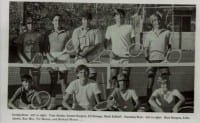 I was talking to Aleshe’s brother about: “Where do you guys come from?” And here is a picture: Tom is on the bottom here, sitting in the corner (see right-hand image). There’s John – second from the left on the second row. Letterman, played tennis, got involved in other sports, smiling, all these guys in Las Vegas – good lives.
I was talking to Aleshe’s brother about: “Where do you guys come from?” And here is a picture: Tom is on the bottom here, sitting in the corner (see right-hand image). There’s John – second from the left on the second row. Letterman, played tennis, got involved in other sports, smiling, all these guys in Las Vegas – good lives.
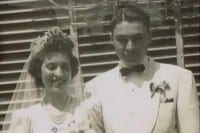 I mean, the parents, the adopted parents were fantastic – that’s their adopted parents, a photo of them (see left-hand picture). The only thing that may be an issue was that the mother Margaret died in 1977, a few years before John went off. Did the loss of his adopted mother change him and make him look at life differently? Tom thought maybe he fell in with a bad crowd.
I mean, the parents, the adopted parents were fantastic – that’s their adopted parents, a photo of them (see left-hand picture). The only thing that may be an issue was that the mother Margaret died in 1977, a few years before John went off. Did the loss of his adopted mother change him and make him look at life differently? Tom thought maybe he fell in with a bad crowd.
He is left with answering as many questions about his brother. One of the things he will not, however, say is that he was a good man. The estate issue after his brother’s death was fantastic. He told me it took 10 years to unwind the legal ramifications of the estate. By the time it was done, there was no money left. So he was never given any money as the sole survivor. People came forward from all directions to go: “We need our money!”
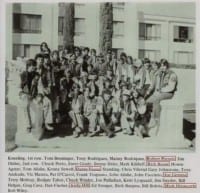 This is another group photo (see right-hand image). If I sound philosophical about this, it’s because as somebody who makes documentaries – anybody who has seen my documentaries, and I’ve made a few about such things as text adventures and bulletin board systems – I very quickly realized that we really don’t care about the metal, we don’t care about the network – we care about the people. Who are the people that do this?
This is another group photo (see right-hand image). If I sound philosophical about this, it’s because as somebody who makes documentaries – anybody who has seen my documentaries, and I’ve made a few about such things as text adventures and bulletin board systems – I very quickly realized that we really don’t care about the metal, we don’t care about the network – we care about the people. Who are the people that do this?
Why do they care? Every time I interviewed people, their answers were always along the lines of “I met my best friend on a computer bulletin board.” It would be less important for them what version of Cnet was running at the time, but who was their friend. And when I see this picture, in this picture is somebody who committed millions of dollars in fraud for the rest of his life. And the rest of them – probably not as much. So, philosophically, it just fascinates me.
 This is one of the cars that he owned (see left-hand image). He was a Corvette collector, and it’s funny to watch his name in documents. I looked through a lot of legal documents that would say things like: “IQuest’s previous owner was a wanted fugitive from the FBI, therefore this, this and this…” And these cars all got sold. This is one of his cars, it says: “Previously, of the Robert Hoquim collection.” So his name lives on in both false and greatness.
This is one of the cars that he owned (see left-hand image). He was a Corvette collector, and it’s funny to watch his name in documents. I looked through a lot of legal documents that would say things like: “IQuest’s previous owner was a wanted fugitive from the FBI, therefore this, this and this…” And these cars all got sold. This is one of his cars, it says: “Previously, of the Robert Hoquim collection.” So his name lives on in both false and greatness.
I was mostly haphazardly looking at this story over the years, and what I thought was interesting is that at one point I went to a computer show in Indianapolis, and I met a man who had been in Indianapolis working on another ISP. They were competitors, but they were also good friends, to as much as these two could be friends. And they would hang out together. And so, he was as shocked as anyone else. But he told me something so amazing. He said: “When you’re an ISP, you’re the center of a network and things can happen. You’re kind of like a landlord, or somebody who owns things. You know, law enforcement takes an interest in you.”
And so, as part of keeping track of crime and other stuff in the late 1990s, Robert Hoquim and this other person would meet with the head of the local FBI office once a month for lunch, for years on end, to catch up on how things were going. And I was like: “He’s on the Wanted list and he’s hanging with the FBI. What an amazing amount of self-control and brass balls!”
And his wife said to me: “Yes, and he died of a heart attack at 41.” And it’s true – he was always on the run. The price he paid for getting to do what he wanted was that he was constantly in fear, this man.
And one of the things that came out in my research, which wasn’t pointed out, was that there had been a clerical error when they were divesting the rest. IQuest had been sold for $14 million, and they indicated in couched and very careful language and stuff that it turned out 7 million of it had ended up in his private account. And I’m sure to them it was like: “Oh, what’s up with that?” And I think the answer was: “He was going to do the bug-out again.” I think he was going to go for it.
In this world we’re living now, with so much being offered to us and so many dreams coming true, I think there’s a lot to be learned from a life like this. I think that there’s a lot to be learned from somebody who looked at the world this way and what things we buy into and just accept, even though we all preach distrust in building networks, and how one smiling face can convince us to undo everything we’ve ever done. Down in the speaker room there’s a beautiful AP that we’re seeing down there called “Perfectly trustable Internet hotspot.”
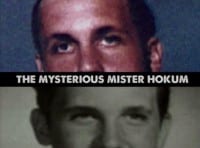 I’ve tried to think: “What did Robert Hoquim think while he was dying?” I don’t know how fast it was; I don’t know how quickly his heart attack took him: 300 pounds, overweight, having rejected all things, all family, having not seen his own brother for 15 years, having not known his own father had died, not knowing who he was going to run to next, but knowing that he had $7 million quietly in the bank that was going to send him to whatever new journey he was going to take. And all I could think was that this man was in this basement apartment in this house, thinking: “I almost made it.”
I’ve tried to think: “What did Robert Hoquim think while he was dying?” I don’t know how fast it was; I don’t know how quickly his heart attack took him: 300 pounds, overweight, having rejected all things, all family, having not seen his own brother for 15 years, having not known his own father had died, not knowing who he was going to run to next, but knowing that he had $7 million quietly in the bank that was going to send him to whatever new journey he was going to take. And all I could think was that this man was in this basement apartment in this house, thinking: “I almost made it.”
Thanks a lot!





























I worked at an electronic store in Indianapolis called ovation, audio video. I knew Bob Holcomb very well. He bought over $40,000 worth of auto gear from me over a 10 year period.
I actually had about 5,000 worth of gear held for him to put in his RV that he used to travel around racing his GT 3000’s.
I never suspected a thing. He was a gentleman demanding, but very friendly.
I was in his house over two dozen times, helping him with his audio and video system. He always had cocktails and smoke and was quite the entertainer I always wondered why he owned in a big house in Carmel, but lived in the basement. He rented the ground floor and upstairs to his race team.
H G Mayse